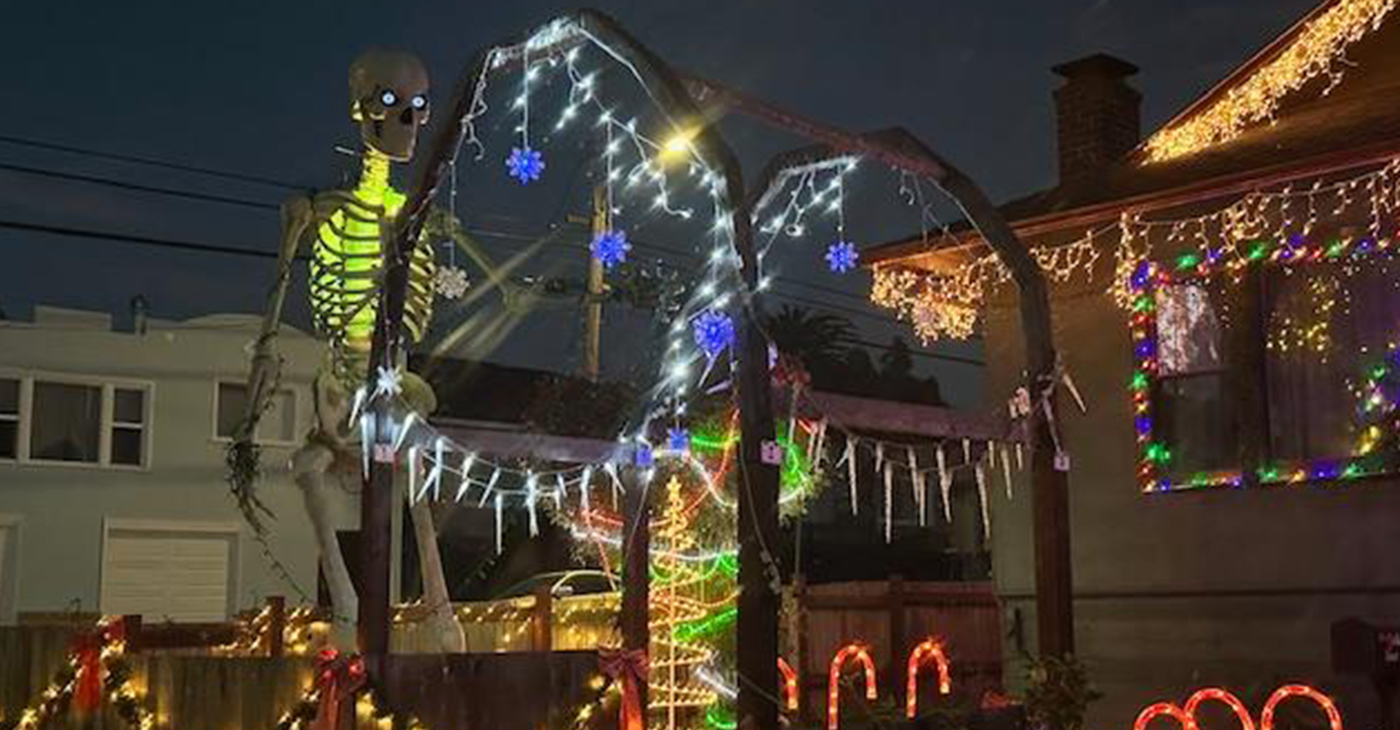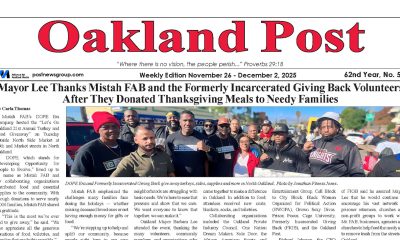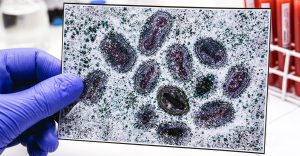Bay Area
West Oakland Churches and Motorcycle Clubs Provide Food and Fellowship to Homeless

Taylor Memorial United Methodist Church hosted a holiday Thanksgiving meal and giveaway on 12th street between Adeline and Magnolia in West Oakland on a bright and sunny Sunday. November 24,2019.
Dozens of church volunteers, led by Pastor Anthony Jenkins, Sr. and First Lady Valerie Jenkins, served a hot meal to hundreds of guests. Seated at 10 circular tables in the church dining hall, people from all walks of life engaged in fellowship over a full Thank s- giving meal of turkey, ham, dressing, macaroni and cheese, yams, salad and rolls.

Pastor Anthony Jenkins. Sr. with his son Cartier Jenkins. Jermaine Jenkins and daughter Alaya Jenkins serving the community with Thanksgiving dinner, clothing, and boxed groceries at their church. Taylor Memorial United Methodist Church in West Oakland. Photo by Carla Thomas.
More than 300 bags of groceries filled with dry goods and items such as canned tuna, canned chicken, boxed macaroni and cheese, as well as other items were also distributed.
“We were prepared to feed thousands.” Jenkins said. “We care about the community and everyone deserves to have food, clothing, and dignity.”
Dining the holiday season it’s common for churches to distribute food. However, it was what took place at the rear of the church and in the parking lot that made this event unique.
A mobile unit provided by Lavamae Organization gave 10 people the opportunity’ to shower throughout the day. A rack packed with free clothing was available to anyone in need of a warm coat, hat or pants. Also free haircuts courtesy of Kutz Barber “Snoop” and Dilema’s Barber Shop were given to 30 people.
On the other side of West Oakland on Mandela Parkway, the street was blocked off from the Target parking lot to 34th street where a combination of churches and motorcycle clubs came together to feed the needy.
Positioned just outside a tough shed homeless encampment were eight decorated, rectangular tables and a full buffet staffed by volunteers of Oakland’s Community Chinch, Grace Baptist Church and Corinthian Church.
‘It’s important for the community to know that we care and we will begin to feed the homeless and underserved regularly.” said Pastor Lawrence VanHook of Community Church.
The Divas to Die for Motorcycle Chub, KynightRiders Motorcycle Club, and the Buffalo Soldiers Motorcycle Clubs also participated. Some of the motorcycle chapter members traveled from as far away as Sacramento and Modesto.
KynightRiders Motorcycle Club of Oakland’s President Champagne Ellison said, ‘Without us helping collectively, these families are suffering. We spend so much time getting excited about a holiday that we can afford, but what about those who can’t? We wake up in the morning with our Christmas and shopping lists, and we forget about the ones that can’t
do that and it’s heartbreaking.
‘Tm excited to be here enjoying family and friends while feeding those in need,” said Kynight Riders Motorcycle Club member, LaToya Herron.
When a resident of the adjacent homeless encampment, Tamela Adams, finished her meal, she gathered her to-go plate for later and paused in her tracks. With tears in her eyes, she expressed her gratitude to volunteers before walking through the gates of where she has called home the past month.
“I live here with one of my three sons and have been displaced for nearly nine years,” she said of the city-sanctioned encampment behind her.
“Thank you for being here and putting us first,” she said.
“That’s what it’s all about, said Gene Gilliam, president of the Oakland Chapter of the Buffalo Soldiers Motorcycle
Club. Gilliam, a retired veteran of 33 years in the U.S. Army says he was proud to serve his country’ but feels joy serving his community.
“We want people to be shown that they are loved and cared about,” said Gilliam. “When the Buffalo Soldiers of the U.S. Army served the country beginning in 1844, they were called The Colored Troopers. From that time on, our people (Blacks/ African Americans) have always shown how much they love their country and its people. Our motorcycle club just carries that tradition on – but we don’t discriminate by color, we care about everyone regardless of color. Instead of just dropping off food, we sit, eat and talk with them (the homeless), and extend our family and brotherhood.”
“It’s always wonderful to see grassroots efforts from the goodness of their hearts, to make sure our most vulnerable residents who are unsheltered have a wonderful holiday,” said Brigitte Cook, senior constituent liaison, for Oakland District 3 Councilwoman Lynette McElhaney.
Activism
Oakland Post: Week of December 24 – 30, 2025
The printed Weekly Edition of the Oakland Post: Week of – December 24 – 30, 2025

To enlarge your view of this issue, use the slider, magnifying glass icon or full page icon in the lower right corner of the browser window.
Alameda County
Bling It On: Holiday Lights Brighten Dark Nights All Around the Bay
On the block where I grew up in the 1960s, it was an unwritten agreement among the owners of those row homes to put up holiday lights: around the front window and door, along the porch banister, etc. Some put the Christmas tree in the window, and you could see it through the open slats of the blinds.

By Wanda Ravernell
I have always liked Christmas lights.
From my desk at my front window, I feel a quiet joy when the lights on the house across the street come on just as night falls.
On the block where I grew up in the 1960s, it was an unwritten agreement among the owners of those row homes to put up holiday lights: around the front window and door, along the porch banister, etc. Some put the Christmas tree in the window, and you could see it through the open slats of the blinds.
My father, the renegade of the block, made no effort with lights, so my mother hung a wreath with two bells in the window. Just enough to let you know someone was at home.
Two doors down was a different story. Mr. King, the overachiever of the block, went all out for Christmas: The tree in the window, the lights along the roof and a Santa on his sleigh on the porch roof.
There are a few ‘Mr. Kings’ in my neighborhood.
In particular is the gentleman down the street. For Halloween, they erected a 10-foot skeleton in the yard, placed ‘shrunken heads’ on fence poles, pumpkins on steps and swooping bat wings from the porch roof. They have not held back for Christmas.
The skeleton stayed up this year, this time swathed in lights, as is every other inch of the house front. It is a light show that rivals the one in the old Wanamaker’s department store in Philadelphia.
I would hate to see their light bill…
As the shortest day of the year approaches, make Mr. King’s spirit happy and get out and see the lights in your own neighborhood, shopping plazas and merchant areas.
Here are some places recommended by 510 Families and Johnny FunCheap.
Oakland
Oakland’s Temple Hill Holiday Lights and Gardens is the place to go for a drive-by or a leisurely stroll for a religious holiday experience. Wear a jacket, because it’s chilly outside the Church of Jesus Christ of Latter-day Saints, at 4220 Lincoln Ave., particularly after dark. The gardens are open all day from 9 a.m. to 9 p.m. with the lights on from dusk until closing.
Alameda
Just across the High Street Bridge from Oakland, you’ll find Christmas Tree Lane in Alameda.
On Thompson Avenue between High Street and Fernside drive, displays range from classic trees and blow-ups to a comedic response to the film “The Nightmare Before Christmas.” Lights turn on at dusk and can be seen through the first week in January.
Berkeley
The Fourth Street business district from University Avenue to Virginia Street in Berkeley comes alive with lights beginning at 5 p.m. through Jan. 1, 2026.
There’s also a display at one house at 928 Arlington St., and, for children, the Tilden Park Carousel Winter Wonderland runs through Jan. 4, 2026. Closed Christmas Day. For more information and tickets, call (510) 559-1004.
Richmond
The Sundar Shadi Holiday Display, featuring a recreation of the town of Bethlehem with life-size figures, is open through Dec. 26 at 7501 Moeser Lane in El Cerrito.
Marin County
In Marin, the go-to spot for ‘oohs and ahhs’ is the Holiday Light Spectacular from 4-9 p.m. through Jan. 4, 2026, at Marin Center Fairgrounds at 10 Ave of the Flags in San Rafael through Jan. 4. Displays dazzle, with lighted walkways and activities almost daily. For more info, go to: www.marincounty.gov/departments/cultural-services/department-sponsored-events/holiday-light-spectacular
The arches at Marin County Civic Center at 3501 Civic Center Dr. will also be illuminated nightly.
San Francisco
Look for light installations in Golden Gate Park, chocolate and cheer at Ghirardelli Square, and downtown, the ice rink in Union Square and the holiday tree in Civic Center Plaza are enchanting spots day and night. For neighborhoods, you can’t beat the streets in Noe Valley, Pacific Heights, and Bernal Heights. For glee and over-the-top glitz there’s the Castro, particularly at 68 Castro Street.
Livermore
The winner of the 2024 Great Light Flight award, Deacon Dave has set up his display with a group of creative volunteers at 352 Hillcrest Avenue since 1982. See it through Jan. 1, 2026. For more info, go to https://www.casadelpomba.com
Fremont
Crippsmas Place is a community of over 90 decorated homes with candy canes passed out nightly through Dec. 31. A tradition since 1967, the event features visits by Mr. and Mrs. Claus on Dec. 18 and Dec. 23 and entertainment by the Tri-M Honor Society at 6 p.m. on Dec. 22. Chrippsmas Place is located on: Cripps Place, Asquith Place, Nicolet Court, Wellington Place, Perkins Street, and the stretch of Nicolet Avenue between Gibraltar Drive and Perkins Street.
Alameda County
Oakland Council Expands Citywide Security Cameras Despite Major Opposition
In a 7-1 vote in favor of the contract, with only District 3 Councilmember Carroll Fife voting no, the Council agreed to maintain its existing network of 291 cameras and add 40 new “pan-tilt-zoom cameras.”

By Post Staff
The Oakland City Council this week approved a $2.25 million contract with Flock Safety for a mass surveillance network of hundreds of security cameras to track vehicles in the city.
In a 7-1 vote in favor of the contract, with only District 3 Councilmember Carroll Fife voting no, the Council agreed to maintain its existing network of 291 cameras and add 40 new “pan-tilt-zoom cameras.”
In recent weeks hundreds of local residents have spoken against the camera system, raising concerns that data will be shared with immigration authorities and other federal agencies at a time when mass surveillance is growing across the country with little regard for individual rights.
The Flock network, supported by the Oakland Police Department, has the backing of residents and councilmembers who see it as an important tool to protect public safety.
“This system makes the Department more efficient as it allows for information related to disruptive/violent criminal activities to be captured … and allows for precise and focused enforcement,” OPD wrote in its proposal to City Council.
According to OPD, police made 232 arrests using data from Flock cameras between July 2024 and November of this year.
Based on the data, police say they recovered 68 guns, and utilizing the countywide system, they have found 1,100 stolen vehicles.
However, Flock’s cameras cast a wide net. The company’s cameras in Oakland last month captured license plate numbers and other information from about 1.4 million vehicles.
Speaking at Tuesday’s Council meeting, Fife was critical of her colleagues for signing a contract with a company that has been in the national spotlight for sharing data with federal agencies.
Flock’s cameras – which are automated license plate readers – have been used in tracking people who have had abortions, monitoring protesters, and aiding in deportation roundups.
“I don’t know how we get up and have several press conferences talking about how we are supportive of a sanctuary city status but then use a vendor that has been shown to have a direct relationship with (the U.S.) Border Control,” she said. “It doesn’t make sense to me.”
Several councilmembers who voted in favor of the contract said they supported the deal as long as some safeguards were written into the Council’s resolution.
“We’re not aiming for perfection,” said District 1 Councilmember Zac Unger. “This is not Orwellian facial recognition technology — that’s prohibited in Oakland. The road forward here is to add as many amendments as we can.”
Amendments passed by the Council prohibit OPD from sharing camera data with any other agencies for the purpose of “criminalizing reproductive or gender affirming healthcare” or for federal immigration enforcement. California state law also prohibits the sharing of license plate reader data with the federal government, and because Oakland’s sanctuary city status, OPD is not allowed to cooperate with immigration authorities.
A former member of Oakland’s Privacy Advisory Commission has sued OPD, alleging that it has violated its own rules around data sharing.
So far, OPD has shared Flock data with 50 other law enforcement agencies.
-

 #NNPA BlackPress4 weeks ago
#NNPA BlackPress4 weeks agoLIHEAP Funds Released After Weeks of Delay as States and the District Rush to Protect Households from the Cold
-

 Activism4 weeks ago
Activism4 weeks agoOakland Post: Week of November 26 – December 2, 2025
-

 Alameda County3 weeks ago
Alameda County3 weeks agoSeth Curry Makes Impressive Debut with the Golden State Warriors
-

 #NNPA BlackPress4 weeks ago
#NNPA BlackPress4 weeks agoSeven Steps to Help Your Child Build Meaningful Connections
-

 #NNPA BlackPress4 weeks ago
#NNPA BlackPress4 weeks agoSeven Steps to Help Your Child Build Meaningful Connections
-

 #NNPA BlackPress4 weeks ago
#NNPA BlackPress4 weeks agoTrinidad and Tobago – Prime Minister Confirms U.S. Marines Working on Tobago Radar System
-

 #NNPA BlackPress4 weeks ago
#NNPA BlackPress4 weeks agoThanksgiving Celebrated Across the Tri-State
-

 #NNPA BlackPress4 weeks ago
#NNPA BlackPress4 weeks agoTeens Reject Today’s News as Trump Intensifies His Assault on the Press









































